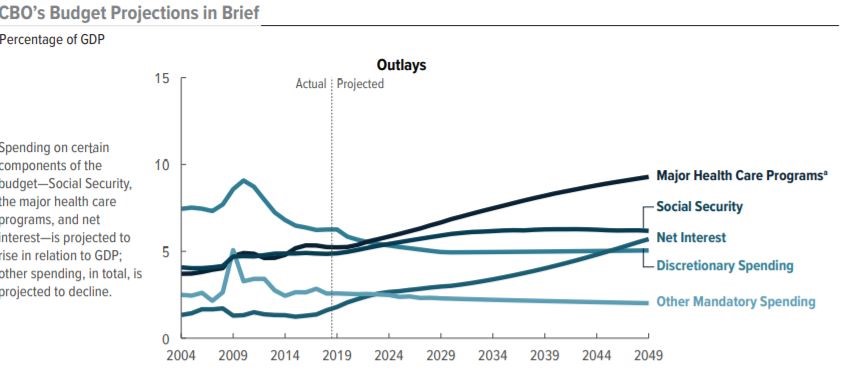Not enough ventilators, a profound lack of personal protective equipment (PPE) and overwhelmed healthcare professionals. Hospitals and systems stretched beyond capacity in the hardest hit states. Routine care ground to a halt.
COVID-19 has pushed the US healthcare system to its limit and exposed its fragility.
It’s not a big secret that the US healthcare system is complex and inefficient. Healthcare expenditures account for 27.9% of the federal budget (Table 1) and 17.8% of GDP. The cost of US healthcare per person is twice as much as the average in the developed world, and it is the major driver of projected growth in federal government spending over the long term (Graph 1).

Table 1: Source – https://www.hhs.gov/sites/default/files/fy-2019-budget-in-brief.pdf

Graph 1: Source – Congressional Budget Office. GDP = gross domestic product. a. Consists of spending for Medicare (net of premiums and other offsetting receipts), Medicaid, and the Children’s Health Insurance Program, as well as outlays to subsidize health insurance purchased through the marketplaces established under the Affordable Care Act and related spending.
Given this sizeable budget, one would imagine that the US would have been prepared to handle a global pandemic. But we weren’t — healthcare workers are working without proper PPE that could save their lives; the national stockpile was not adequately replenished after 2009, and the CDC has failed to adequately test and treat to reduce economic disruption. Further, delay in action and implementation of core epidemiological principles led to the federal government playing catch-up, with considerable consequences to patients, front-line providers and the healthcare system itself. Pandemic management requires upfront economic investment, but the post-pandemic long-term outcomes intricately depend on it.
The Struggle among Profit, Productivity and Patient Care
The federal government isn’t the only entity unprepared. Healthcare institutions over the last decade have long struggled with an internal conflict among profit, productivity and patient care. We have seen healthcare administration grow at a rate far outpacing that of physician growth (3200% over the last 35 years), in part to handle the increased requirements of navigating insurers, coding, reimbursement and federal regulations. There are many conflicting opinions on this; but I think it’s safe to say that the shift of healthcare structure from that of small practices to larger groups and corporations has resulted in a greater focus on profitability, with the end result of trimming anything perceived as an excess. This business model of healthcare has led to greater involvement of private equity firms seeking a solid return on investment from health systems; but this “business first” philosophy has left many individual healthcare institutions with little buffer to handle simple disruptions in profit, much less an epidemic.
The disruptions in routine medical care caused by the pandemic highlight several economic problems. Excess resources in healthcare are typically minimal, and the cost of obtaining PPE and equipment to fight a disease that has a high critical care burden is likely to quickly drain the coffers. Social distancing, conservation and capacity concerns have led to many institutions cancelling high-margin elective procedures and other revenue-generating activities that keep hospitals and practices profitable and operational. The expensive cost to provide care to complex COVID-19 patients combined with the uncertainty regarding future reimbursement creates a situation for some that will be financially unviable. Some institutions are already instituting pay cuts across the board and furloughing staff – health care workers (HCW) included – to ride out the storm (not great for workforce morale). We’ve seen some CEO’s donate a portion of their salary to employee bailout funds. While this is a much-appreciated gesture, it also highlights the need for a more robust financially solvent structure in healthcare systems that does not rely on emergency measures and the government.
The Human Cost of COVID-19 to the Medical Community
All of this doesn’t even begin to touch on the human cost of COVID-19 to the medical community—every HCW lost to the disease is an irreplaceable loss to those that love and depend on them. Their patient communities suffer as well, losing both trusted relationships and years of cumulative medical training and clinical experience. HCW loss and disability have considerable economic ripples. Practices, hospital systems and the overall medical capacity of the system to provide medical care are directly impacted. In the case of physicians, consider some of the indirect costs — the federal government is the single largest provider of graduate medical education subsidy (in the amount of $16 billion) through various programs like Medicare/Medicaid. Hospitals and patients directly experience the economic loss of productivity and patient care, but the American taxpayer shoulders some of this burden as well.
This also takes a significant toll on all other patients beyond those directly impacted by COVID-19. Individuals with chronic illnesses, cancer and other progressive diagnoses will get more ill due to the current limitations in care. There has already been a decrease in the number of heart attacks, strokes and other emergencies presenting to the emergency department; and patients that do present are often showing up with more advanced and critical illness. This scenario will have both a human and economic impact on the system as a whole. It generates losses at every end of the spectrum via increased care expenditure for heightened disease states and losses in profit through preventative care.
Searching for Solutions
With so many issues to address, where can we begin to find solutions? SHM’s COVID-19 position statement calls for PPE and other resources to battle the pandemic and protect HCWs. I strongly support this as it is an important step to preventing healthcare economic collapse. A protected, healthy workforce with good morale is key to recuperating the system.
Secondly, an infusion of funding is needed now to keep the doors open until business as usual can resume. Recent congressional legislation, the CARES act, allocates $100 billion to healthcare. It’s a reasonable short-term solution, but it is not enough. It certainly does not address every financial burden that we face and does not mention the frontline healthcare providers that are battling this invisible war. On a positive note, the US Department of Health and Human Service’s OIG (Office of the Inspector General) has published a report outlining the challenges faced by frontline workers and hospital systems for consideration by the federal government – needless to say that immediate action would be required to mitigate damages already done and those that are yet to occur.
We must also give thought to how to handle the surge of routine care and elective procedures that will occur after the pandemic has ended. Telehealth and remote medicine have provided potential for continuation of routine care delivery and preventive medicine, which hopefully will improve patient outcomes over time. Rollbacks on regulations with HIPAA and billing in telemedicine offer an avenue for practices to maintain a small semblance of a revenue stream. But this won’t solve the care delivery issue in full, and planning for what happens after will be key.
Lastly, we need to prepare better in the future. Prioritizing profit over preparedness has led to a healthcare system that is not well-equipped to handle an epidemic much less a full-scale pandemic. Not only are we left with a gap in our understanding of a novel disease, but we are also forced to handle system inefficiencies during this difficult time. There is value in physicians and administrators working together to ensure that the system is flexible enough to handle anything thrown at it. After all, shutting down isn’t an option in healthcare, so we need to learn from our mistakes.
Economy and humanity are not mutually exclusive. Once we can look towards the future, our focus must be on measures that align profitability with the values of care-giving and organizational strategies that place providers and patients at the forefront. Coordinated support and new ways of approaching old problems through strong, bold leadership both within institutions and at the federal level are needed to enable the healthcare industry to do what it should best – save lives.



Hi Soumya
It’s a great article focusing on the real world scenarios that’s happening in all health systems across the country during this article .
I think this is a new normal until there is a vaccine. But the new normal should not prevent or delay timely care for our patients . We have to find innovative solutions to provide usual care , elective surgeries with the ongoing pandemic . I am so proud to say that our private Hospitalist group gave hike to our hospitalists acknowledging the invaluable service our employees provide in frontlines risking their lives on a daily basis